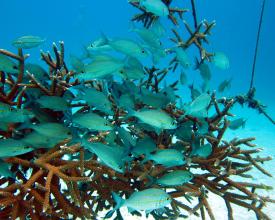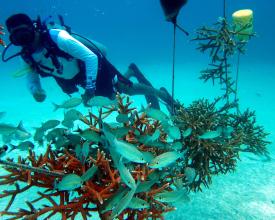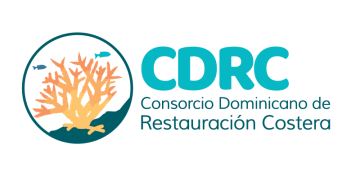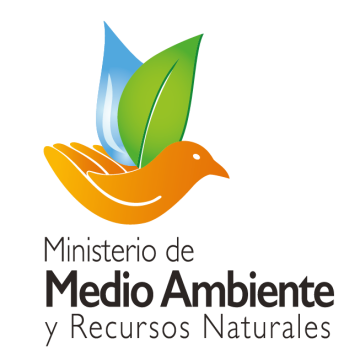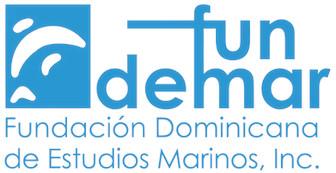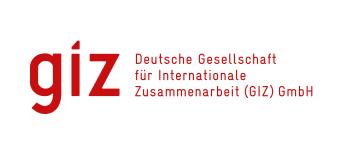
Restoring life underwater: A Multi-Stakeholder Partnership to save coral reefs in the Dominican Republic

Dominican Republic (DR) is known for its tourism, that relies on the ecosystem services provided by coral reefs. However, it has suffered the impacts of climate change and coastal development, making coral reefs more vulnerable. Restoration became a popular alternative to safeguard this ecosystems. It started to grow rapidly lacking control and causing many nurseries to become abandoned. This concern triggered the creation of the Dominican Coastal Restoration Consortium (CDRC), a Multi-Stakeholder Partnership that works with the Ministry of Environment. Nowadays, members of the CDRC are providing support to the Ministry, monitoring coral nurseries all over the country and leading the evaluations, as well as steering the restoration initiatives in the DR.
Context
Challenges addressed
- The first challenge was to structure and set a country wide platform for the coordination of coral reef restoration initiatives.The initial growth of coral reef restoration projects in Dominican Republic was not well organized , there was a lack of coordination between stakeholders and information regarding the goals, situation, and results of restoration projects, and this information was not collected and/or shared.
- The second challenge was related to the lack of long term financing for coral reef restoration initiatives.
- The third challenge was the need of a private-public arrangement for the evaluation of coral reef restoration projects. The Ministry of Environment and the non profits and private sector restoration initiatives needed an agreement to do this.
- The fourth challenge was to create a tool for the evaluation of restoration projects in the country.
Location
Process
Summary of the process
The building blocks are part of a chronologic sequence of activities directed to the consolidation of the multistakeholder partnership. Each one has it´s own importance and is complemented by the other two building blocks. A Multi-Stakeholder Partnership with a common goal is the base for a collaborative effort between institutions. Afterwards, a formal agreement for the country wide evaluation of coral reef nurseries was needed, along with a tool for this matters. Considering the sustainability of this two previous blocks, a financial mechanism to ensure that the initiative is maintained over time and to foster private sector engagement was constructed.
Building Blocks
Creation of the Multi-Stakeholder Partnership
In the Dominican Republic, coral reef restoration became a popular alternative to try to safeguard this ecosystems. At the beginning, it started to grow rapidly lacking control and causing many nurseries to become abandoned. This concern triggered the creation of the Dominican Coastal Restoration Consortium (CDRC), a Multi-Stakeholder Partnership that works with along with the Ministry of Environment monitoring coral nurseries all over the country and leading the nursery evaluations, as well as steering the restoration initiatives in the DR.
Enabling factors
- Existing interest of several local organizations in getting thigs done the right way, without harming the environment.
- Willingness of local organizations and authorities to share knowledge and expertise.
- The need of structure and a nation wide platform to coordinate and regulate coral reef restoration activities.
Lesson learned
- A common goal for the stakeholders must be identified, so that everyone benefits from the partnership and it will always be a win-win situation.
- Specific roles and capabilities must be defined from the beginning.
- Formal agreements must be prepared in time so that the implementation of the activities is not delayed.
- Definition of a functional steering structure for the partnership is a must at the beginning.
Construction of a private-public agreeement and a tool for the evaluation of coral reef nurseries
There was a need to collaborate between stakeholders and secure the resources to carry out specific field activities like the monitoring and evaluation of coral reef nurseries, which cannot be carried out solely by the public or the private sector indenpendently. In the DR, an agreement between the CDRC (Dominican Coastal Restoration Consortium) and the Ministry of Environment was signed so that the CDRC could lead the monitoring and evaluation of every coral nursery in the country, with the technical support of the Ministry.
In order to carry out the monitoring and evaluation of coral nurseries, the CDRC created a specific manual.
Enabling factors
- Willingness of public and private institutions to work toghether.
- A shared objective for both institutions.
- The need of monitoring and evaluation of nurseries all along the country.
- Technical and scientific knowledge and expertise.
Lesson learned
- Involvement of public institutions in processes carried out by private sector or NGOs is key to achieve goals and have access to projects, in this case nurseries, in every part of the country.
- A good explanation, including field activities, for government officials and decision makers is key to achieve engagement.
- A good suggestion would be to try to keep things simple. An agreement like this one should be easy to understand and focused on one specific subject.
Constitution of a financial mechanism for the private sector investment in coral reef conservation and restoration
Along with the stakeholders involved in the partnership, a well structured financial mechanism was established. In order to achieve this, a legal analysis was performed, looking into existing payment for ecosystem services schemes in the DR and in other countries (eg. Costa Rica). After that, an initial structure for the mechanism was proposed and discussed in several workshops with the partnership members and representatives of other relevant institutions. Finally, a concerted version of the structure for the mechanism was implemented.
Enabling factors
- Private sector involvement
- Willingness of every stakeholder to be part of this
- One organization leading the whole process, in this case CDRC, working closely to the Ministry of Environment
- Several income options (diversification of the income alternatives)
- Learning form previous national and regional experiences
Lesson learned
- A financial mechanism is key to assure the sustainability of this kind of initiatives.
- Getting to know and understand successful experiences in other countries can help build a local case.
- There is no "recipe" that can be follwed to create a financial mechanism for biodiversity conservation. Experiencies can be taken into account, but the mechanism must be made "ad hoc" for each place, considering local characteristics and conditions.
Impacts
The Dominican Coastal Restoration Consortium (CDRC) conserves and restores coral reef ecosystems to enhance environmental and social resilience against the impacts of climate change and other degrading factors through the application of practical approaches in which communities can actively participate.
The CDRC, with the legal authorization and technical support of the Ministry of the Environment, leads the process of coral nursery evaluation throughout the Dominican Republic (DR). Achieving this goal is a challenge that the CDRC has addressed through an evaluation tool that ends up with recommendations for each of the country’s restoration projects so that each nursery is strengthened, and conservation efforts continue. This solidly advancing assessment aims at consolidating standardized procedures for nursery configuration, maintenance, data collection, information exchange, and general performance.
Nowadays, CDRC is the leading institution in coral restoration efforts in the DR and is also a regional model, sharing their skills and knowledge with other countries like Costa Rica and Honduras. In DR, a total of 17 coral nurseries are managed by CDRC members and monitored and evaluated by the CDRC staff.
Beneficiaries
Direct beneficiaries include local NGOs and local communities, users of the coral reef, private sector benefitting from reef ecosystem services, and the Ministry of Environment of the Dominican Republic.
